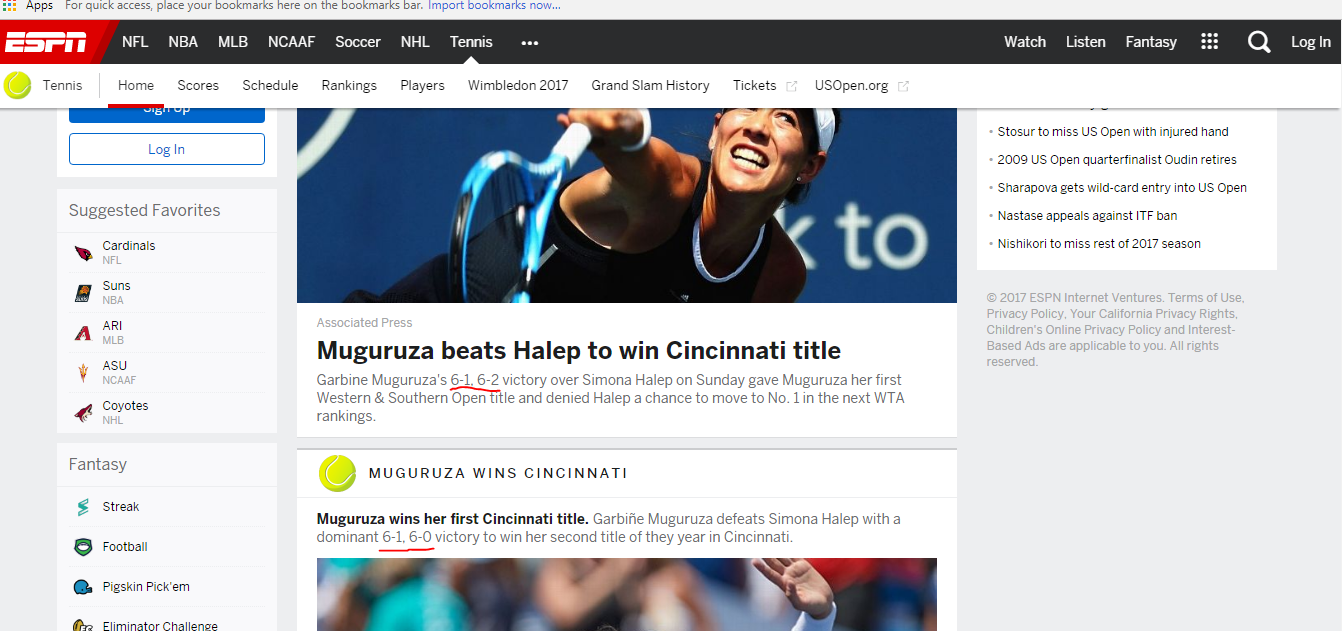As many people may know, I'm something of a tennis fan, and follow professional tennis fairly closely. Since I've been following pro tennis for the past decade or so, I've developed a decent repertoire of tennis trivia, which has been useful only for impressing my friend while we were watching the U.S. Open, and talking tennis history with my hitting partner.
In order to keep up with the goings-on of pro tennis, I usually look to sports broadcaster ESPN, and their website at espn.com/tennis.
What's funny about being a tennis fan in America is that tennis is definitely not at the top of the sports totem pole here, and it shows sometimes in the reporting of it. While ESPN for the most part does a decent-enough job of reporting on tennis, it sometimes blatantly reveals that the writers aren't 100% dedicated to the facts.
This was hilariously displayed on the front page of the website for today's date (08/20/2017), reporting on Garbiñe Muguruza's victory over Simona Halep in the Western & Southern Open (more commonly referred to as the Cincinnati Masters).
What's shown in the picture that I screengrabbed from their site is that they have headlines for two different stories that each give a different score for the match. In this case, it doesn't even take someone with a vast array of tennis knowledge to notice the error, all you have to do is be able to see that two numbers are different!
What's even funnier is that when I clicked on the top article, it says that the score is 6-1, 6-0 in the article itself. I didn't watch the match, but I guess 6-1, 6-0 is the correct score since it is also the score listed in the "scores" section of the website.
Significance of This Error
What's the greater significance of this gaff in reporting of the score? Not a lot. While it clearly displays that whoever was in charge of writing the headline was too lazy to take 10 seconds to double check the score, the factual error does not really change the takeaway at all. While 6-1, 6-0 is a more embarrassing score for Simona Halep than 6-2, 6-1, both scores represent something of a "beatdown", so it doesn't really matter.
What does matter is that the error exists, and could point to other errors. Today it's a slight inaccuracy of a tennis score, but tomorrow it could something that actually affects the way in which one sees the world. It's like the saying that for every cockroach you see in your house, there are 100 in the walls that you don't see (sleep tight!).
It reminds me of a little anecdote about one of my favorite bands: Van Halen. During their heyday with David Lee Roth in the 1980s, Van Halen would play in sold-out arenas across the country, dazzling audiences with their excellent musicianship and quirky stage antics. Their high-profile performances necessitated written contracts with the venue on various technical features of said venue, one of which included a provision that their back-stage room have a bowl of M&Ms, with a rider that there were to be absolutely no brown M&Ms. Legend has it that if they played at a venue and were greeted with a bowl of M&Ms that contained brown candies, then they took the liberty of going on an insane destructive tear through the backstage room.
So, why the request for no brown M&Ms? As any M&M connoisseur knows, the candies do not vary in flavor based on color, all M&M colors have the same chocolate flavor. I'm not exactly sure why they chose brown as the color that they didn't want (maybe they were racist?) but it was indeed an arbitrary decision. It was, however, more than just an eccentric request by egotistical rock stars. The provision that there were no brown M&Ms served as a "canary in a coal mine" for the venue. Since their performances relied on a great deal of coordination between many different people in order to go off without a hitch, there was a great chance of something going wrong that could derail the performance. The band members wanted to make sure that a venue was detail-oriented, and paid attention to seemingly insignificant requests. If they didn't read a provision about brown M&Ms, then what else might they have missed that could bring bigger ramifications?
The same thing is true with media outlets. If they can't get a score in a tennis match right, then what else are they missing?
Journalists aren't perfect, so it's important for us as the consumers of media to always be on the lookout for errors in reporting. Some may be minuscule, but others could be quite important.




How do we discern real news with fake news? That is the million dollar question!
Checking the sources to see if they are reputable is a good start, albeit tedious